A superstition specific to pipe smoking warns that a pipe should never be lit from a burning lamp or candle, which, according to the French, will provoke a wife to argumentativeness, and possibly even infidelity. Blowing smoke rings is, however, a good omen said to promote the luck of both the smoker and those in the immediate vicinity. Among American Indians, smoking a pipe of peace is an important social ritual and no one must refuse to take a puff if the pipe is offered to them. The ceremony must be done in total silence--if anyone speaks, the pipe must be dropped at once. Disaster will befall anyone who attempts to smoke from it again.Just a little something from email inbox, thanks to Brer.--from Cassell's Dictionary of Superstitions by David Pickering
Saturday, November 29, 2008
Pipe superstitions
Featured Pipe Smoker (Art): Alchemist by Adriaen van Ostade
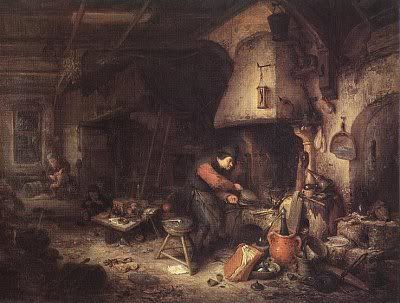
Alchemist by Adriaen van Ostade (1610-1685)
In this painting by Dutch painter Adriaen van Ostade, an alchemist tends his fire surrounded by his accoutrements and equipment. His clay pipe and spectacles lie on the stool behind him. Bad place, if you ask me. If he absent-mindedly sits down he'll break his pipe and his glasses at the same time.
Van Ostade was born Adriaen Hendricx in the town of Ostade, Holland. He adopted the name "van Ostade" as a painter, as did his brother Isaack. He was a Baroque-era artist who was influenced by Rembrandt. One source says he created 385 paintings, another source states that it was really more than 900. In any case, he was very prolific. Most of his works portrayed homely scenes such as taverns, village fairs, and various country settings.
Adriaen van Ostade links at Wikipedia and Artcyclopedia.
NOTE: There will be no further Featured Pipe Smokers for the month of December, because of a special series of illustrations I have lined up to run through Christmas. The regular weekly Featured Pipe Smoker will return in January.
Wednesday, November 26, 2008
Vintage Ad (1943): "I Smoke a Kaywoodie"

As I mentioned before, Kaywoodie made a big selling point out of advertising their use of real Mediterranean briar, because they had large stockpiles of it and during the war there was no way to import more. Some other U.S. pipe makers ran out and tried to use American briar, which is not fit for pipes by any means.
Based on inflation, the pipe above would cost $140 right now. That was a lot of money to be shelling out for a pipe in 1943. An expensive pipe like this was certainly at least a Prime Grain, but more likely was a Flame Grain (both high-end Kaywoodie grades). With wood of this quality, the meerschaum insert is only a sales gimmick--it wouldn't improve the smoking qualities at all, except in that the usual cake build-up would be neither necessary nor even desired.
During this era, Kaywoodie stopped using a white cloverleaf logo and instead used a white circle with a black cloverleaf outline in the center of it. The logo could be either on the top or side of the stem.
Saturday, November 22, 2008
Featured Pipe Smoker: Aaron Spelling

Aaron Spelling (1923-2006)
Born in Dallas, Texas, Aaron Spelling served in the Air Force (at that time I think it was known as the Army Air Corps) before attending Southern Methodist University in Dallas and graduating in 1949 with a Bachelor of Arts degree.
His first foray into showbiz was as an actor, with a small part in the movie Vicki in 1953. He also acted in several movies and TV shows, such as I Love Lucy, Gunsmoke, and Alfred Hitchcock Presents. However, his success came in writing and producing. His first work at producing was for Zane Grey Theater in 1957. He continued to produce TV shows prolificly from then on, and was the producer for such notable series as The Mod Squad (1968), S.W.A.T. (1975), Starsky and Hutch (1975), The Rookies (1975), Family (1976), Charlie's Angels (1976), Fantasy Island (1977), The Love Boat (1977), Hart to Hart (1979), Dynasty (1981), T.J. Hooker (1982), and Melrose Place (1992), plus a lot of others.
His huge mansion was considered by some outrageously extravagant even by Hollywood standards, and is supposedly the largest single-family dwelling in California. He has a place in the Guinness Book of World Records as the most prolific television producer. He is listed as producing over 200 TV shows by imdb.com.
His children Tori Spelling and Randy Spelling are both actors.
He was said to have been a lifelong smoker until he was diagnosed with oral cancer in 2001. He suffered a stroke on June 18, 2006 and died from complications related to the stroke five days later on June 23.
Wednesday, November 19, 2008
Vintage Ad (1972): Ronson Pipes
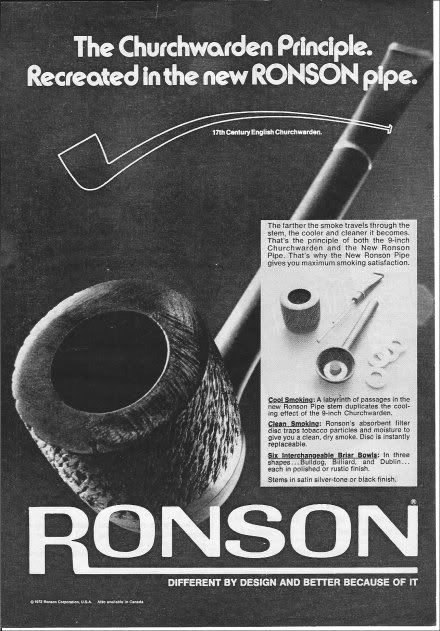
So it appears that Ronson, now known primarily for its lighter fluid and little else, once made and sold pipes. This is another gimmick pipe in the pattern of the Falcon, by which I mean it had a metal body with interchangeable screw-on briar bowls. The only Falcon I ever had didn't use any filters, however.
But the real gimmick here is the "labyrinth of passages" in the stem which were supposed to duplicate the length of a nine-inch churchwarden and thereby produce a cooler smoker. Did it really work? I have no way of knowing, but I'd guess it's more gimmick than real effect. The metal rod attachment that's part of the bit looks very much like the Kirsten design, so I don't know exactly how the "labyrinth" worked, but anything with a "labyrinth of passages" in the stem sounds to me like it would be very difficult to clean. Although I suppose it could be cleaned pretty well using a pipe retort.
Saturday, November 15, 2008
Featured Pipe Smoker (Art): Shoshone Warrior with Pipe by Alfred Miller

Shoshone Warrior with Pipe by Alfred Jacob Miller
Not a person, but a painting of someone whose name is apparently lost to history. According to the book I scanned this from, the artist said the warrior's pipe was "the great solace of his leisure hours."
As for the artist, Alfred Jacob Miller (1810-1874) was born in Baltimore, and it is written that he was the first artist of his generation to explore the American West. He accompanied an expedition led by Sir William Drummond Stewart in 1837, following a route that later became known as the Oregon Trail. He witnessed one of the fur trappers' annual rendezvous on the Green River in what is now Wyoming.
After the expedition, he returned to his home town of Baltimore, where he remained until his death, creating many works of art based on the sights he had seen during his journey into the west. Few people knew of his works during his lifetime, and it wasn't until after his death that his art came to the attention of the general public.
An entry on Miller with many links leading to online exhibitions of his work can be found at artcyclopedia.
The pipe in the portrait is made of a wooden (or perhaps, cane or reed) stem with the bowl undoubtedly carved from the rock known as pipestone or Catlinite.
Wednesday, November 12, 2008
Vintage Ad (1946): Van Roy
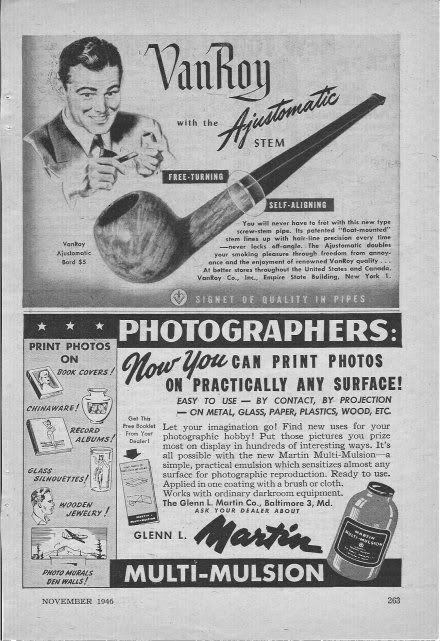
Kaywoodies were famous (or infamous, to some) for their screw-in stems. However, they had a problem of eventually getting off-center because of the very slight wear to the fitment threads every time the stem was removed and replaced. Kaywoodie tried to fix this by making each pipe with a slightly off-center rightward cant. That is, if you held the new pipe in your mouth, the bowl would cant slightly to the right. As time went by, it would eventually line up dead center. Of course, as even more time went by, it would begin slanting slightly leftward due to continuing thread wear.
So Dr. Grabow (also famous or infamous, depending) came up with the "Ajustomatic" screw-in stem. Similar to Kaywoodie's, except that the screw-in fitment wasn't fixed as tightly and permanently into the stem. That way one could use just a little extra force to line up the bowl and stem at the desired angle. But if you fiddled with it too much, or it just wore out from age and use, it became very loose and you'd pretty much just have to go buy yourself a whole new pipe.
Since this ad uses the term "Ajustomatic," I must assume that Van Roy was another variety of Dr. Grabow.
Saturday, November 8, 2008
Featured Pipe Smoker: Aleister Crowley

Aleister Crowley (1875-1947)
What can I say about Mr. Crowley? If you know of him, it would be hard for me to say anything that you don't already know. If you don't know of him, there's more to say than I can write here.
Born Edward Alexander Crowley, his family were members of a conservative evangelical Christian sect called the Plymouth Brethren. His father had become quite wealthy in the brewery business, and had already retired when Aleister was born. During his retirement, his father dedicated himself to preaching. As sometimes happens in even the best of families, he rebelled against his family's strict Christian beliefs and went in other directions.
Crowley is probably best known these days as an outspoken occultist, and perhaps his most famous statement was, "Do what thou wilt shall be the whole of the law." Say what you want about him, but I don't think anyone can argue that he didn't practice what he preached.
Crowley was also a master chess player, a mountain climber, poet, writer, painter, astrologer, drug experimenter (and addict) and a philosophical commenter. He was also sometimes accused of racism and mysogyny. During his time he was called "the wickedest man in the world" and liked to refer to himself as "the Great Beast 666," among other things.
He became involved in occult matters as a young adult with the Golden Dawn, but as was his way, he eventually broke from them and founded his own occult philosophy, known today as Thelemic Mysticism. He practiced many forms of "magick," involving meditation as well as sex and drugs (rock and roll having not yet been invented).
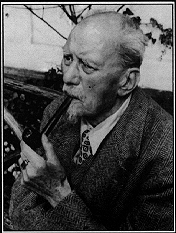
As for his pipe smoking, I have no way to verify it, but I have read on more than one occasion that Crowley liked to smoke straight Perique flavored with rum. The flavoring of tobacco with rum is an old tradition and is not especially remarkable. However, smoking straight Perique may be described to the non-pipe smoker as eating a meal of straight jalapeño peppers and nothing else. Some people can do it, but not many would enjoy it. A thorough description of Perique would require me to write a whole new post, but for now I'll just say that it is created by aging the leaves under pressure and allowing them to ferment in their own juices for a length of time. This creates a very strongly flavored and pungent tobacco. It is normally used as a "spice" tobacco, that is, it is added to blends in small amounts for flavor, the way you might add salt or spices to food.
Crowley, having squandered his inheritance throughout his life, died penniless and addicted to opium of a respiratory infection in 1947.
Wednesday, November 5, 2008
Vintage Ad (1960): Wally Frank
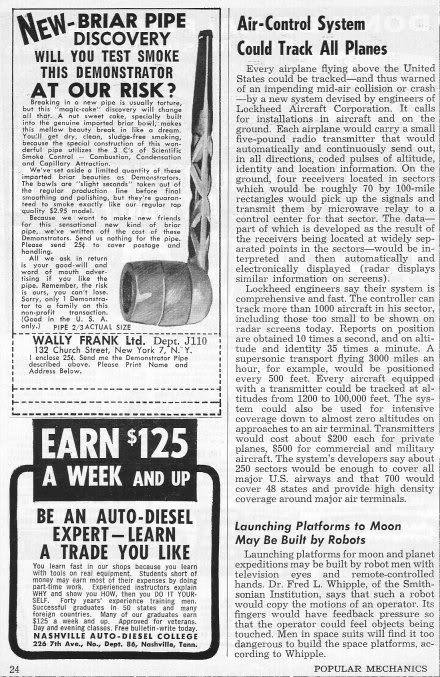
Wally Frank was another pipe maker from the United States that seems to have developed a sort of cult following among collectors of cheaper pipes. Every time I sold one on eBay there was a flurry of bids for it and the final bid always surprised me at how high it went.
Here's one in which they combine at least three different gimmicks:
1. Threaded interchangeable bowl.
2. Pre-caked bowl.
3. Aluminum "radiator" stem.
Not that there's anything wrong with any of these gimmicks, or anything wrong with this particular pipe. However, breaking in a new pipe that has a completely naked inner bowl is not torture. I've always enjoyed it, actually.
Wally Frank also had something going for a while that might get modern nannyists into a frothing fit. They had a "Pipe of the Month Club." Members would receive a brand new Wally Frank pipe in the mail once a month. Of course, several tobacco distributors have had the same kind of program, at one time or another.
I've had a few Wally Franks pass through my hands. They were decent pipes. Nothing spectacular, but fine smokers nonetheless. Every one I had, I eventually resold, mainly because they kept selling so high. I mean, if I pay ten bucks for a box full of old pipes, and the Wally Frank sells for more than I paid for the entire lot, it's hard to not sell it.
Sunday, November 2, 2008
Poll results
Question: What does the tonquin flavor in 1792 Flake smell/taste like to you?
28 Responses:
Chocolate -- 2 (7%)
Vanilla -- 2 (7%)
Chocolate Coffee -- 2 (7%)
Vanilla Coffee -- 2 (7%)
Tonquin, of course! -- 7 (25%)
Chicken -- 0
Blasphemous scents from outside the spectrum of mortal sensation, of which no man may breathe the noisome vapours and still remain wholly sane. -- 11 (39%)
Other -- 2 (7%)
Thanks for playing!
28 Responses:
Chocolate -- 2 (7%)
Vanilla -- 2 (7%)
Chocolate Coffee -- 2 (7%)
Vanilla Coffee -- 2 (7%)
Tonquin, of course! -- 7 (25%)
Chicken -- 0
Blasphemous scents from outside the spectrum of mortal sensation, of which no man may breathe the noisome vapours and still remain wholly sane. -- 11 (39%)
Other -- 2 (7%)
Thanks for playing!
Saturday, November 1, 2008
Featured Pipe Smoker: George Lincoln Rockwell
It may well be impossible to find a neutral account of George Rockwell's life. I will try to stick to the facts as I know them (and even they may be wrong), and avoid editorializing.
Born in Bloomington, Illinois, Rockwell's parents were both vaudevillians and actors. Though brought up as a Christian, he later considered himself an agnostic; still later, he identified himself with the racist "Christian identity" movement. He attended Brown University in Providence, Rhode Island and majored in philosophy. In 1939 he quit school to join the U.S. Navy, since he had come to the conclusion that war with Nazi Germany was unavoidable. He attended flight school and earned his wings in 1940. He served in the Pacific theater and participated in the retaking of Guam.

After the war, he became a commercial artist, opening a photography studio and painting signs. In 1948 he won a $1,000 award for an ad he made for the American Cancer Society. He civilian life was interrupted when he was recalled to active duty at the beginning of the Korean War. He served in California, training Navy and Marine pilots.
Rockwell was married twice but had no children (as far as I can tell).
During his time in California he became an ardent anti-communist and supporter of Joe McCarthy. He also supported Douglas MacArthur's bid for president, adopting the corncob pipe in emulation of the famous photo of MacArthur.
In 1958 he protested the sending of U.S. troops to the Middle East. An admirer sent him an enormous swastika flag, which he turned into the centerpiece of a shrine to Adolf Hitler. He soon became a leader in the American Nazi movement, making white supremacy the focus of his political activism.
 In 1959 he formed the American Nazi Party. He ran the lecture circuit, and was in high demand, lecturing against non-whites, Jews, and communists (he considered Jews to be communists anyway). He formed alliances with the Ku Klux Klan and other supremacist groups. In 1967 he changed the name of the American Nazi Party to the National Socialist White People's Party (apparently completely missing the irony of claiming to be an opponent of communism while simultaneously calling himself a socialist). He was also a holocaust denier (surprise, surprise).
In 1959 he formed the American Nazi Party. He ran the lecture circuit, and was in high demand, lecturing against non-whites, Jews, and communists (he considered Jews to be communists anyway). He formed alliances with the Ku Klux Klan and other supremacist groups. In 1967 he changed the name of the American Nazi Party to the National Socialist White People's Party (apparently completely missing the irony of claiming to be an opponent of communism while simultaneously calling himself a socialist). He was also a holocaust denier (surprise, surprise).Rockwell died of multiple gunshot wounds on August 25, 1967. The man convicted for his murder was one of his own followers whom he had been feuding with, but there is still some debate as to the real identity of his murderer.
Upon being informed of Rockwell's death, his own father is said to have stated, "I am not surprised at all. I’ve expected it for quite some time."
Subscribe to:
Posts (Atom)

